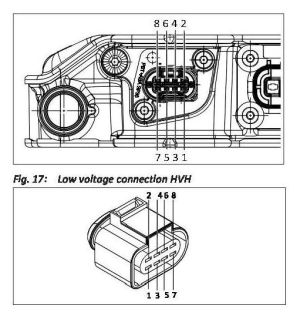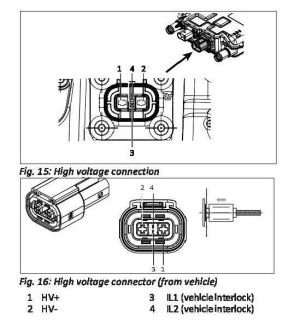Webasto HVH50: Difference between revisions
(Corrected IDs) |
Jsimonkeller (talk | contribs) No edit summary |
||
| (13 intermediate revisions by 3 users not shown) | |||
| Line 1: | Line 1: | ||
[[File:Webasto HVH50.jpg|thumb|232x232px|Webasto HVH50 water heater]] | [[File:Webasto HVH50.jpg|thumb|232x232px|Webasto HVH50 water heater]] | ||
The Webasto HVH series are electrical water heaters typically used in popular PHEV. | The Webasto HVH series are electrical water heaters typically used in popular PHEV. They come in various models, such as the HVH50, HVH50plus, HVH70plus, HVH100 and in versions that run up to 400V and 800V. | ||
== Connectors == | == Connectors == | ||
[[File:Webasto HVH50 connectors.jpg|thumb|Webasto HVH50 connectors]] | [[File:Webasto HVH50 connectors.jpg|thumb|Webasto HVH50 connectors]] | ||
The HV connector is a Tyco HVA280 connector with A-key (might be different on other devices). | The HV connector is a Tyco HVA280 connector with A-key (might be different on other devices). Part # HVA 280 / TE Internal #: '''4-2103177-2''' / TE Internal Description: PLUG ASSY, KEY B, FA,CPA, HVA280-2PHI XE<ref>https://www.te.com/usa-en/product-4-2103177-2.html</ref>. | ||
The small center pins are for interlock (detect that the connector is seated). The right pin (with tab facing upwards) is HV+, the left one HV- | The small center pins are for interlock (detect that the connector is seated). The right pin on the connector (FIG 16 / with tab facing upwards) is HV+, the left one HV- | ||
The LV connector is best found by the VW part number 1J0973714 | The LV connector is best found by the VW part number 1J0973714 | ||
| Line 13: | Line 13: | ||
* Pin 2 is an analog output | * Pin 2 is an analog output | ||
* Pin 3 is an analog or PWM input | * Pin 3 is an analog or PWM input | ||
* Pin 5 and 7 are interlock | * Pin 5 and 7 are interlock - not sure what to do with it, can be left floating. | ||
* Pin 6 is LIN | * Pin 6 is LIN | ||
* Pin 4 and 8 are unused | * Pin 4 and 8 are unused | ||
Ground must be connected to the case via a stud. | Ground must be connected to the case via a stud. | ||
[[File:Webasto1.jpg|left|thumb|Low Voltage Connector Pin Layout]] | |||
[[File:Webasto2.jpg|thumb|Pin Layout For HV Connector]] | |||
== Communication & Control == | == Communication & Control == | ||
While there is a document describing the [https:// | While there is a document describing the [https://openinverter.org/forum/download/file.php?id=8774 LIN interface] , Webasto seems to have altered the interface for different OEMs. According to the document, LIN bus speed is 19200 but on a unit obtained from ebay it was 9600. So always try both. | ||
The data format | The data format found on one device is as follows. The scaling is identical to the document. The document is not clear on bit positions, so they may or may not be compatible | ||
{| class="wikitable" | {| class="wikitable" | ||
|+HVH LIN Protocol | |+HVH LIN Protocol | ||
!Command | !Command | ||
! | !ID | ||
!Byte 1 | !Byte 1 | ||
!2 | !2 | ||
| Line 37: | Line 68: | ||
|- | |- | ||
|Write power | |Write power | ||
|35 | |21 (35) [34] | ||
| | |Power limit | ||
1 digit=40W | |||
|Temp setpoint | |Temp setpoint | ||
1 digit=1 degree | 1 digit=1 degree | ||
Offset -40 | Offset -40 | ||
| | |0 | ||
| 8=on | |||
| - | | - | ||
| - | | - | ||
| - | | - | ||
| - | | - | ||
|- | |||
|Read Meas | |||
|22 (24) [39] | |||
|Status | |||
4=running | |||
|Outlet temp | |||
Scaling as above | |||
|Inlet temp | |||
| - | | - | ||
|Voltage LSB | |||
|Voltage MSB - 2 bits | |||
Power LSB - 6 bits | |||
|Power MSB | |||
1 digit=20W | |||
|Unknown | |||
|- | |- | ||
|Read Status | |Read Status | ||
|40 | |23 (40) | ||
|various | |various | ||
|status | |status | ||
| Line 61: | Line 107: | ||
| | | | ||
| | | | ||
|} | |} | ||
Some units allow control via a simple on off signal on Pin 3 (12V=heat up liquid to 85°C) and some units allow a strange PWM control between 50-100Hz where 25%-81% duty cycles allow setting various power levels. | IDs in () are from the manual in 19200 baud, the other ones are those I actually found in 9600 baud. IDs in [] are from a 2017 Volvo XC90/XC60/S90 HVH50 heater running at 19200 baud. | ||
Some units allow control via a simple on off signal on Pin 3 (12V=heat up liquid to 85°C) and some units allow a strange PWM control between 50-100Hz where 25%-81% duty cycles allow setting various power levels. On my ebay unit this did not work. Only 12V and LIN needed to be connected, all else unconnected. | |||
A discussion of the various ways to program this heater can be found at https://openinverter.org/forum/viewtopic.php?t=1565 | |||
[[Category:OEM]] [[Category:Webasto]] [[Category:HVAC]] | |||
Latest revision as of 22:03, 3 March 2024
The Webasto HVH series are electrical water heaters typically used in popular PHEV. They come in various models, such as the HVH50, HVH50plus, HVH70plus, HVH100 and in versions that run up to 400V and 800V.
Connectors
The HV connector is a Tyco HVA280 connector with A-key (might be different on other devices). Part # HVA 280 / TE Internal #: 4-2103177-2 / TE Internal Description: PLUG ASSY, KEY B, FA,CPA, HVA280-2PHI XE[1].
The small center pins are for interlock (detect that the connector is seated). The right pin on the connector (FIG 16 / with tab facing upwards) is HV+, the left one HV-
The LV connector is best found by the VW part number 1J0973714
- Pin 1 is permanent 12V
- Pin 2 is an analog output
- Pin 3 is an analog or PWM input
- Pin 5 and 7 are interlock - not sure what to do with it, can be left floating.
- Pin 6 is LIN
- Pin 4 and 8 are unused
Ground must be connected to the case via a stud.
Communication & Control
While there is a document describing the LIN interface , Webasto seems to have altered the interface for different OEMs. According to the document, LIN bus speed is 19200 but on a unit obtained from ebay it was 9600. So always try both.
The data format found on one device is as follows. The scaling is identical to the document. The document is not clear on bit positions, so they may or may not be compatible
| Command | ID | Byte 1 | 2 | 3 | 4 | 5 | 6 | 7 | 8 |
|---|---|---|---|---|---|---|---|---|---|
| Write power | 21 (35) [34] | Power limit
1 digit=40W |
Temp setpoint
1 digit=1 degree Offset -40 |
0 | 8=on | - | - | - | - |
| Read Meas | 22 (24) [39] | Status
4=running |
Outlet temp
Scaling as above |
Inlet temp | - | Voltage LSB | Voltage MSB - 2 bits
Power LSB - 6 bits |
Power MSB
1 digit=20W |
Unknown |
| Read Status | 23 (40) | various | status | info |
IDs in () are from the manual in 19200 baud, the other ones are those I actually found in 9600 baud. IDs in [] are from a 2017 Volvo XC90/XC60/S90 HVH50 heater running at 19200 baud.
Some units allow control via a simple on off signal on Pin 3 (12V=heat up liquid to 85°C) and some units allow a strange PWM control between 50-100Hz where 25%-81% duty cycles allow setting various power levels. On my ebay unit this did not work. Only 12V and LIN needed to be connected, all else unconnected.
A discussion of the various ways to program this heater can be found at https://openinverter.org/forum/viewtopic.php?t=1565



